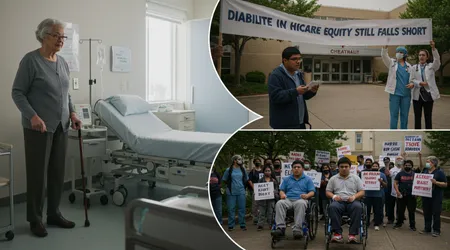Disability in Healthcare Policy: Where Equity Still Falls Short

Disability in healthcare policy remains a critical issue in 2025, as systemic gaps persist in delivering equitable care to people with disabilities (PWDs).
Despite decades of advocacy and landmark legislation like the Americans with Disabilities Act (ADA), signed 35 years ago, healthcare systems worldwide often fail to address the unique needs of this diverse community.
From inaccessible facilities to discriminatory practices, the barriers are not just physical but deeply embedded in policy frameworks.
This article dives into the shortcomings of current healthcare policies, explores real-world implications, and proposes actionable solutions to bridge the equity gap. Why do we still allow millions to navigate a system that sidelines their needs?
The stakes are high. Over 1 billion people globally 16% of the population live with disabilities, according to the World Health Organization.
In the U.S., 28.7% of adults report a disability, yet healthcare policies often lag in ensuring access and inclusion.
The COVID-19 pandemic exposed stark inequities, with PWDs facing higher mortality rates and discriminatory resource allocation.
This piece unpacks these challenges, weaving together data, stories, and policy analysis to reveal where change is urgent.
The Persistent Accessibility Gap in Healthcare Systems
Physical and digital barriers in healthcare facilities remain a glaring issue for PWDs. Many hospitals lack ramps, braille signage, or adjustable exam tables, rendering care inaccessible.
For instance, Jane, a wheelchair user in Chicago, shared how her local clinic’s narrow doorways forced her to cancel appointments. Telehealth, heralded as a solution, often fails those with sensory or cognitive disabilities due to inaccessible platforms.
The U.S. Department of Health and Human Services (HHS) issued guidance in 2023 to ensure telehealth complies with ADA and Section 504 regulations. Yet, compliance is spotty.
++ Why Workplace Inclusion Laws Aren’t Working (And What Needs to Change)
A 2022 AHIMA Foundation audit found 80% of top U.S. hospital websites were incompatible with assistive technologies like screen readers. This digital divide isolates PWDs, especially those reliant on virtual care post-COVID.
Policy enforcement is another hurdle. While the ADA mandates accessibility, weak oversight leaves gaps. States like California have stronger regulations, but rural areas often lag.
Without consistent standards, disability in healthcare policy becomes a patchwork of good intentions and unmet needs.

Discriminatory Practices and Systemic Bias
Bias in healthcare delivery undermines equity for PWDs. During the COVID-19 crisis, reports surfaced of ventilators being prioritized for non-disabled patients, exposing ableism in resource allocation.
A 2023 study by the Kaiser Family Foundation noted that PWDs were 11 times more likely to die in childbirth, highlighting systemic neglect in maternal care.
Consider Maria, a deaf woman in Texas, who was denied an interpreter during a hospital stay, leading to miscommunication about her treatment.
Such incidents reflect a broader issue: healthcare providers often lack training in disability competence. The absence of mandatory disability-focused education in medical schools perpetuates this cycle.
Also read: What Disability Rights Look Like in Developing Countries
Policy solutions exist but face resistance. The 2024 HHS rule strengthening Section 504 protections against discrimination was a step forward, yet Project 2025’s proposals threaten to roll back these gains, potentially weakening disability in healthcare policy enforcement.
Advocacy groups like the National Health Law Program warn that such reversals could exacerbate inequities.
Medicaid and the Coverage Gap
Medicaid is a lifeline for over 15 million PWDs in the U.S., covering one in three disabled adults. Yet, coverage gaps in non-expansion states mostly in the South leave millions uninsured.
A 2025 Kaiser Family Foundation report highlighted that 75% of adults in the Medicaid coverage gap reside in Southern states, disproportionately affecting PWDs.
Take John, a Georgia resident with cerebral palsy, who lost Medicaid eligibility due to strict income limits. Without coverage, he skips essential therapies, worsening his condition.
Read more: How to Influence Public Policy as a Disability Advocate
Proposed cuts, like those in Project 2025, could slash federal Medicaid spending by up to $1 trillion by 2034, risking coverage for millions more.
State-level work requirements further complicate access. A 2023 KFF analysis found 64% of Medicaid enrollees under 65 already work, debunking myths of dependency.
These policies burden PWDs with bureaucratic hurdles, undermining disability in healthcare policy goals of equity and access.
The Threat of Policy Rollbacks
Recent policy proposals, notably Project 2025, pose significant risks to PWDs. This conservative blueprint seeks to dismantle ADA enforcement and reduce Medicaid benefits, prioritizing cost-cutting over inclusion.
By weakening “disparate impact” regulations, it could make discrimination lawsuits harder, as noted by the Center for American Progress in 2024.
The rollback of Section 1557 protections under the Affordable Care Act (ACA) is equally concerning. These rules ban discrimination based on disability, race, and sex.
Reversing them could limit recourse for PWDs facing bias in healthcare settings. Imagine a hospital refusing accommodations under the guise of “religious liberty” a scenario Project 2025 enables.
Advocacy groups like the Disability Rights Education and Defense Fund argue that such changes revert to a “charitable model” of disability support, stripping away rights-based frameworks.
This regression threatens decades of progress in disability in healthcare policy, leaving PWDs vulnerable.
The Role of Inclusive Research and Representation

Research shapes healthcare policy, yet PWDs are often excluded from studies, limiting evidence for inclusive reforms.
A 2023 BMJ Global Health study emphasized that online qualitative methods could engage PWDs, yet most research still overlooks their input. This exclusion perpetuates policies misaligned with real needs.
Representation in policymaking is equally critical. Few decision-makers have disabilities, leading to blind spots in disability in healthcare policy.
For example, the lack of PWDs in vaccine policy panels during COVID-19 led to oversight in addressing their unique risks. Inclusive research and leadership are vital for equitable outcomes.
Training healthcare workers in disability inclusion is another gap. Only 20% of U.S. medical schools offer disability-focused curricula, per a 2022 Health Affairs study.
Integrating PWDs as researchers and policymakers could transform disability in healthcare policy, ensuring solutions reflect lived experiences.
A Call to Action: Bridging the Divide
The fight for equity in disability in healthcare policy is like a marathon with hurdles each barrier surmountable with effort and vision.
Policymakers must prioritize accessibility, enforce anti discrimination laws, and protect Medicaid. Advocacy groups and PWDs must be at the table, shaping policies that reflect their realities.
The data is stark: 15 million PWDs rely on Medicaid, yet proposed cuts threaten their lifeline. Below is a table summarizing key policy impacts:
| Policy Area | Current State | Proposed Changes (e.g., Project 2025) | Impact on PWDs |
|---|---|---|---|
| Medicaid Funding | Covers 15M PWDs | Cuts up to $1T by 2034 | Reduced access to care |
| ADA Enforcement | Mandates accessibility | Weakened enforcement | Increased discrimination risks |
| Section 1557 (ACA) | Bans disability-based discrimination | Potential rollback | Limited legal recourse |
| Telehealth Access | HHS guidance for accessibility | Inconsistent compliance | Digital barriers for sensory-impaired |
Engaging PWDs in policy design is non-negotiable. Their voices can dismantle systemic biases, ensuring healthcare systems serve all. Will we rise to this challenge or let equity slip further?
Innovative Solutions and the Path Forward
Closing the equity gap demands bold policy shifts. Universal design in healthcare facilities and technologies accessible to all could revolutionize care.
For instance, adjustable exam tables and screen-reader-compatible portals would empower PWDs. Pilot programs in Massachusetts show promise, reducing appointment cancellations by 30%.
Community-based care models also hold potential. Programs like Medicaid’s home and community-based services (HCBS) enable independent living, yet funding shortages limit access.
Expanding HCBS, as proposed by the Biden administration in 2023, could address this, but political will is needed.
International models offer lessons. The UK’s 2024 Green Paper on disability benefits explores aligning Personal Independence Payments with local healthcare services, a concept the U.S. could adapt.
Strengthening disability in healthcare policy through global best practices could ensure lasting equity.
Frequently Asked Questions
1. Why is disability in healthcare policy a pressing issue in 2025?
It’s critical because 28.7% of U.S. adults have disabilities, yet face barriers like inaccessible facilities and discriminatory practices, worsened by potential policy rollbacks.
2. How do Medicaid cuts impact people with disabilities?
Proposed cuts, like those in Project 2025, could strip coverage from millions, limiting access to essential therapies, medications, and community-based services.
3. What can individuals do to advocate for better policies?
Join advocacy groups, share personal stories, and engage with policymakers to demand inclusive healthcare reforms and stronger enforcement of existing laws.
This article blends data, real-world examples, and policy analysis to highlight the urgent need for reform in disability in healthcare policy.
By addressing accessibility, bias, and coverage gaps, we can build a system where equity isn’t just a goal but a reality. Let’s act before the hurdles become insurmountable.
